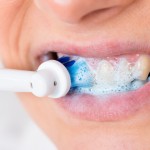
Orthodontic appliances encourage the accumulation of oral biofilm so high quality toothbrushing is important during treatment to prevent the development of white spot lesions and periodontal problems.
The aim of this review was to compare the effectiveness of powered and manual toothbrushes in maintaining oral health during orthodontic treatment.
Methods
Searches were conducted in the PubMed, Cochrane Central Register of Controlled Trials, Cochrane Database of Systematic Reviews, Scopus, Web of Science Core Collection, Arab World Research Source, Clinical Trials.gov and ProQuest Dissertations and Theses Global databases with no restrictions on language or date of publication. Randomised controlled trials (RCTs) of at least 4-weeks duration comparing powered and manual toothbrushing without supervision as part of normal everyday oral hygiene procedures were considered.
Two reviewers independently selected studies, abstracted data and assessed risk of bias. The Cochrane risk of bias tool was used. Data reported at 1-3 months was considered short-term, data > 3months was considered long term. Meta-analysis was undertaken using a random-effects model.
Results
- 9 RCTs involving a total of 434 patients were included.
- 6 used a rotation-oscillation action brush, 1 a side-to-side action, 1 an ionic brush and 1 a brush with bristles pulsating at a frequency of 6000 strokes per minute.
- With the exception of 1 study of 1 year duration the remainder were of 2 months duration or less.
- 1 study was considered to be at low risk of bias the remainder at unclear risk.
- Overall, in the short term,
- there was low-quality evidence that powered toothbrushes provide a statistically significant benefit compared with manual brushing with regard to the gingival index (weighted mean difference, -0.079; 95% confidence interval, -0.146 to -0.012; P = 0.021) and
- indexes assessing gingival bleeding (standardized mean difference, -0.637; 95% confidence interval, -1.092 to -0.183; P = 0.006).
- In the long term, only 1 available study showed a statistically significant benefit of powered over manual toothbrushes with regard to gingival index and bleeding.
- No differences were observed in probing pocket depth and relative attachment loss.
- For the rotation-oscillation brushes statistically significant reductions in gingival index and bleeding were demonstrated only in the long-term study.
Conclusions
The authors concluded: –
Overall, powered toothbrushes may promote gingival health better than manual toothbrushes in orthodontic patients. However, no type demonstrated clear superiority. Better study standardization and reporting in longer follow-up studies are necessary to elucidate the clinical relevance of these results.
Comments
The reviewers have searched a wide range of databases for RCTs comparing powered and manual toothbrushes in patients undergoing orthodontic treatment. While 9 RCTs were identified these were relatively small and of short duration. While the review found a statistical benefit for powered toothbrushes over manual the clinical importance of this is unclear. Evidence from the update Cochrane review on powered toothbrushes (Dental Elf – 18th Jun 2014) has also demonstrated that powered brushes reduce plaque and gingivitis by more than manual brushes generally. But that review also highlighted that lack of clarity over the clinical importance of the reduction.
Links
Primary Paper
Al Makhmari SA, Kaklamanos EG, Athanasiou AE. Short-term and long-term effectiveness of powered toothbrushes in promoting periodontal health during orthodontic treatment: A systematic review and meta-analysis. Am J Orthod Dentofacial Orthop. 2017 Dec;152(6):753-766.e7. doi:10.1016/j.ajodo.2017.09.003. Review. PubMed PMID: 29173855.
Other references
Original review protocol on PROSPERO
Dental Elf – 18th Jun 2014
Powered toothbrushes reduced plaque and gingivitis more than manual toothbrushes
